Intracellular Trafficking Network of Protein Nanocapsules: Endocytosis, Exocytosis and Autophagy
- PMID: 27698943
- PMCID: PMC5039683
- DOI: 10.7150/thno.16587
Intracellular Trafficking Network of Protein Nanocapsules: Endocytosis, Exocytosis and Autophagy
Abstract
The inner membrane vesicle system is a complex transport system that includes endocytosis, exocytosis and autophagy. However, the details of the intracellular trafficking pathway of nanoparticles in cells have been poorly investigated. Here, we investigate in detail the intracellular trafficking pathway of protein nanocapsules using more than 30 Rab proteins as markers of multiple trafficking vesicles in endocytosis, exocytosis and autophagy. We observed that FITC-labeled protein nanoparticles were internalized by the cells mainly through Arf6-dependent endocytosis and Rab34-mediated micropinocytosis. In addition to this classic pathway: early endosome (EEs)/late endosome (LEs) to lysosome, we identified two novel transport pathways: micropinocytosis (Rab34 positive)-LEs (Rab7 positive)-lysosome pathway and EEs-liposome (Rab18 positive)-lysosome pathway. Moreover, the cells use slow endocytosis recycling pathway (Rab11 and Rab35 positive vesicles) and GLUT4 exocytosis vesicles (Rab8 and Rab10 positive) transport the protein nanocapsules out of the cells. In addition, protein nanoparticles are observed in autophagosomes, which receive protein nanocapsules through multiple endocytosis vesicles. Using autophagy inhibitor to block these transport pathways could prevent the degradation of nanoparticles through lysosomes. Using Rab proteins as vesicle markers to investigation the detail intracellular trafficking of the protein nanocapsules, will provide new targets to interfere the cellular behaver of the nanoparticles, and improve the therapeutic effect of nanomedicine.
Keywords: Autophagy; Endocytosis; Exocytosis; Nanomedicine; Protein nanocapsules..
Conflict of interest statement
The authors declare that no competing interests exist.
Figures


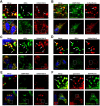
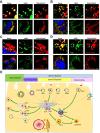
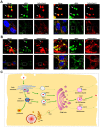

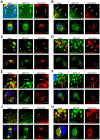
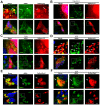

Similar articles
-
Systematic investigation on the intracellular trafficking network of polymeric nanoparticles.Nanoscale. 2017 Mar 2;9(9):3269-3282. doi: 10.1039/c7nr00532f. Nanoscale. 2017. PMID: 28225130
-
Investigation and intervention of autophagy to guide cancer treatment with nanogels.Nanoscale. 2017 Jan 7;9(1):150-163. doi: 10.1039/c6nr07866d. Epub 2016 Dec 2. Nanoscale. 2017. PMID: 27910983
-
Intracellular Trafficking Network and Autophagy of PHBHHx Nanoparticles and their Implications for Drug Delivery.Sci Rep. 2019 Jul 3;9(1):9585. doi: 10.1038/s41598-019-45632-y. Sci Rep. 2019. PMID: 31270337 Free PMC article.
-
Overcoming T. gondii infection and intracellular protein nanocapsules as biomaterials for ultrasonically controlled drug release.Biomater Sci. 2017 Sep 26;5(10):1944-1961. doi: 10.1039/c7bm00425g. Biomater Sci. 2017. PMID: 28776612 Review.
-
Crosstalk between Endo/Exocytosis and Autophagy in Health and Disease.Biotechnol J. 2020 Aug;15(8):e1900267. doi: 10.1002/biot.201900267. Epub 2020 Mar 18. Biotechnol J. 2020. PMID: 32143239 Review.
Cited by
-
Unraveling GLUT-mediated transcytosis pathway of glycosylated nanodisks.Asian J Pharm Sci. 2021 Jan;16(1):120-128. doi: 10.1016/j.ajps.2020.07.001. Epub 2020 Jul 27. Asian J Pharm Sci. 2021. PMID: 33613735 Free PMC article.
-
Intracellular Mechanistic Understanding of 2D MoS2 Nanosheets for Anti-Exocytosis-Enhanced Synergistic Cancer Therapy.ACS Nano. 2018 Mar 27;12(3):2922-2938. doi: 10.1021/acsnano.8b00516. Epub 2018 Mar 12. ACS Nano. 2018. PMID: 29406760 Free PMC article.
-
In Cellulo and In Vivo Comparison of Cholesterol, Beta-Sitosterol and Dioleylphosphatidylethanolamine for Lipid Nanoparticle Formulation of mRNA.Nanomaterials (Basel). 2022 Jul 17;12(14):2446. doi: 10.3390/nano12142446. Nanomaterials (Basel). 2022. PMID: 35889670 Free PMC article.
-
Rab18 binds to classical swine fever virus NS5A and mediates viral replication and assembly in swine umbilical vein endothelial cells.Virulence. 2020 Dec;11(1):489-501. doi: 10.1080/21505594.2020.1767356. Virulence. 2020. PMID: 32419589 Free PMC article.
-
Autophagy Modulated by Inorganic Nanomaterials.Theranostics. 2020 Feb 10;10(7):3206-3222. doi: 10.7150/thno.40414. eCollection 2020. Theranostics. 2020. PMID: 32194863 Free PMC article. Review.
References
-
- Leader B, Baca QJ, Golan DE. Protein therapeutics: a summary and pharmacological classification. Nature Reviews Drug Discovery. 2008;7:21–39. - PubMed
-
- Richard JP, Melikov K, Vives E, Ramos C, Verbeure B, Gait MJ. et al. Cell-penetrating peptides. A reevaluation of the mechanism of cellular uptake. The Journal of biological chemistry. 2003;278:585–90. - PubMed
-
- Biswas A, Joo KI, Liu J, Zhao M, Fan G, Wang P. et al. Endoprotease-mediated intracellular protein delivery using nanocapsules. ACS nano. 2011;5:1385–94. - PubMed
-
- Yan M, Du J, Gu Z, Liang M, Hu Y, Zhang W. et al. A novel intracellular protein delivery platform based on single-protein nanocapsules. Nature Nanotechnology. 2010;5:48–53. - PubMed
-
- Zhao M, Biswas A, Hu B, Joo KI, Wang P, Gu Z. et al. Redox-responsive nanocapsules for intracellular protein delivery. Biomaterials. 2011;32:5223–30. - PubMed
Publication types
MeSH terms
Substances
LinkOut - more resources
Full Text Sources
Other Literature Sources

